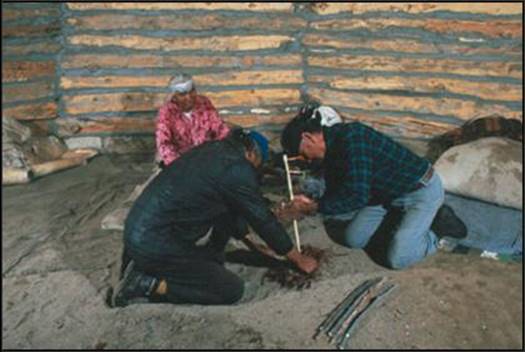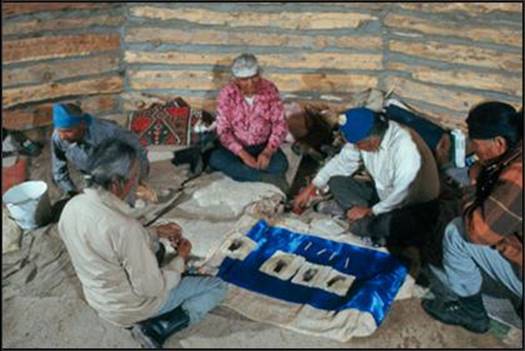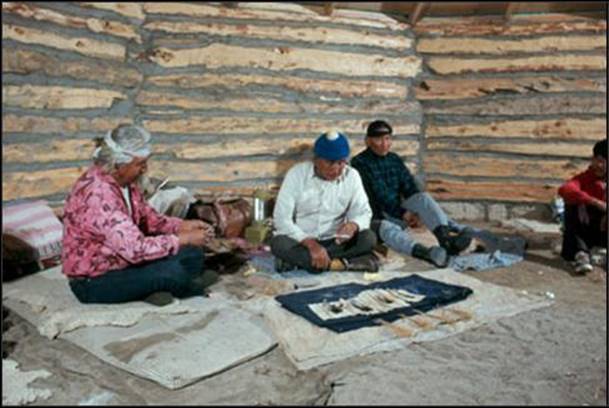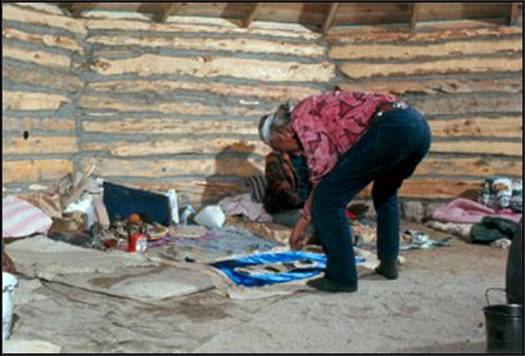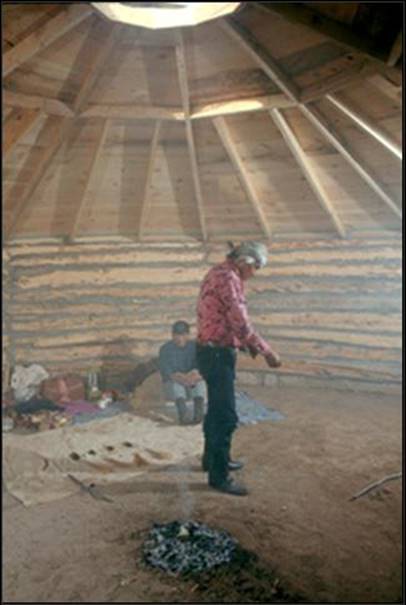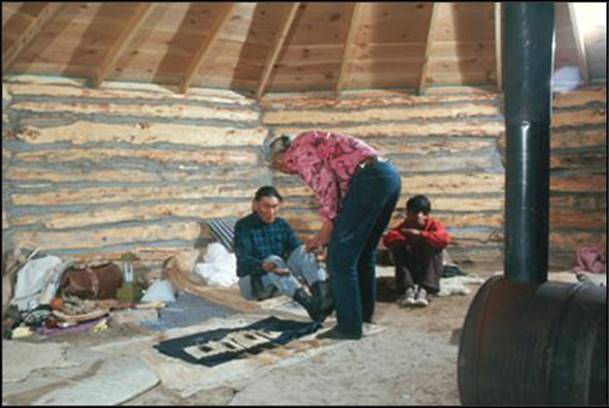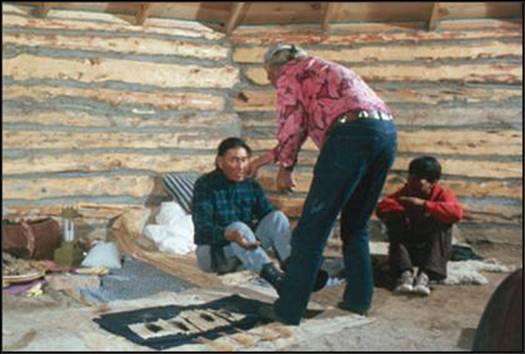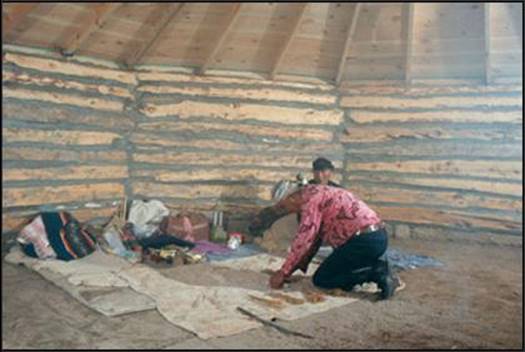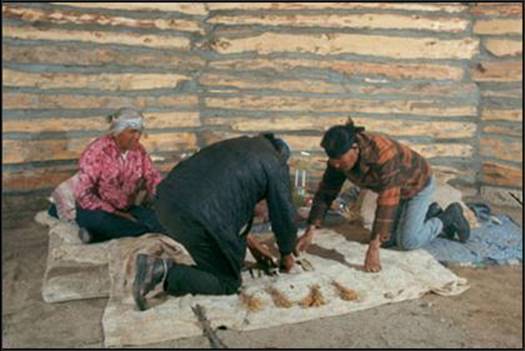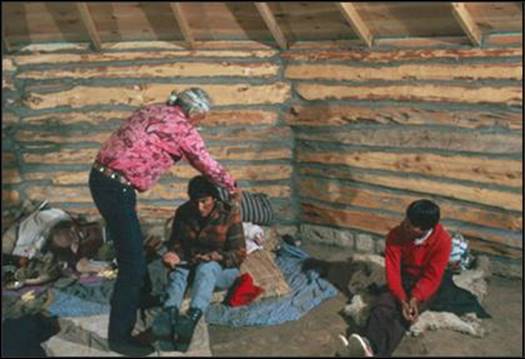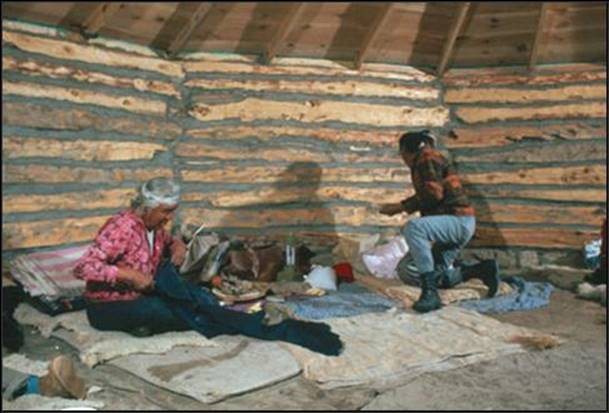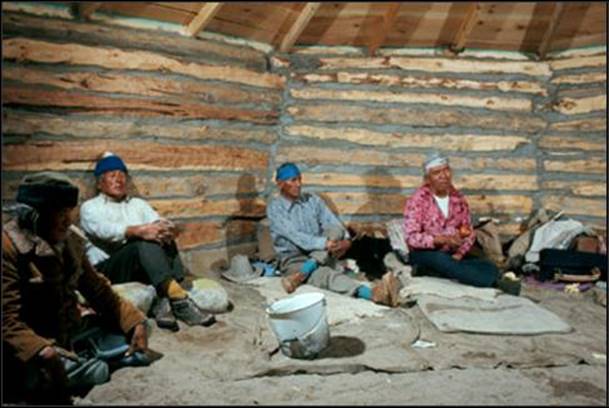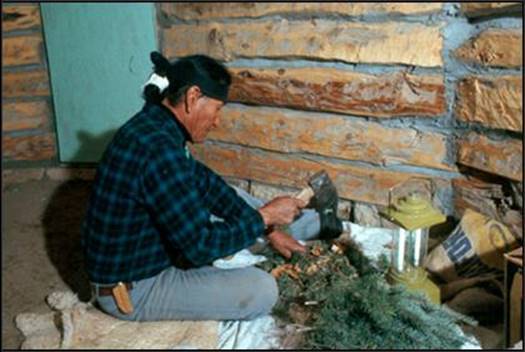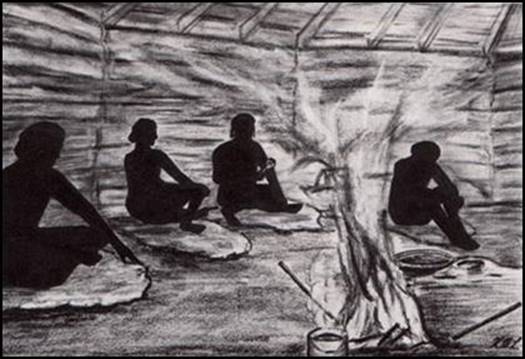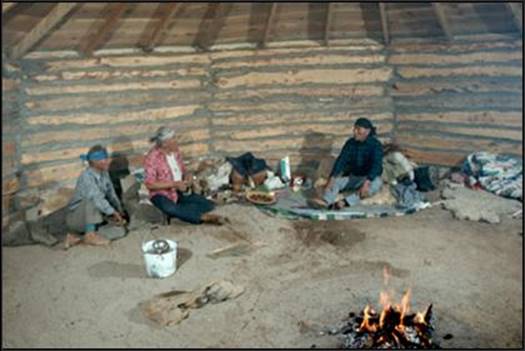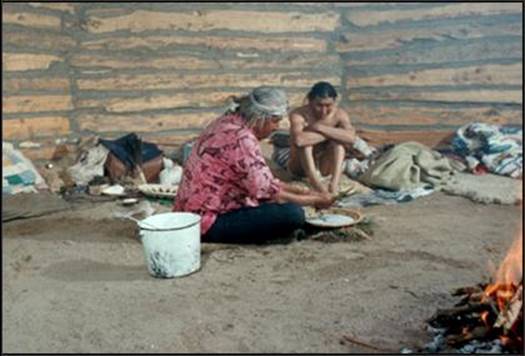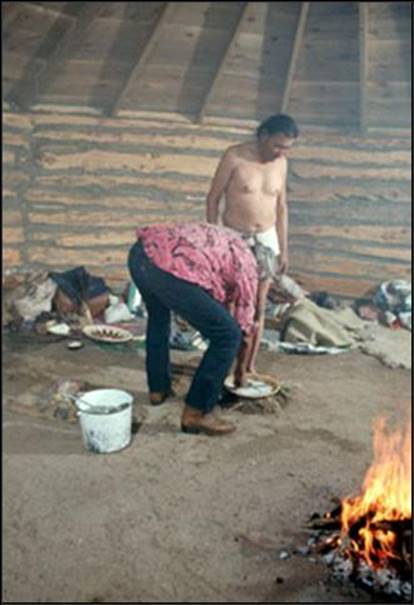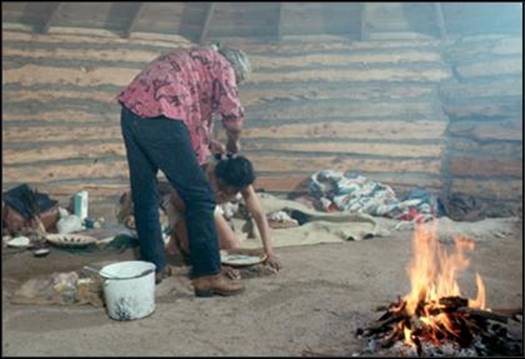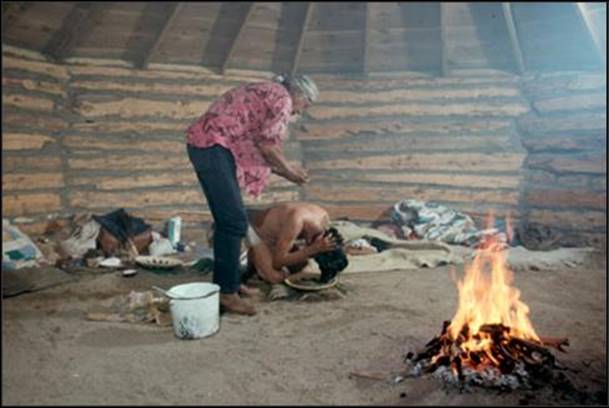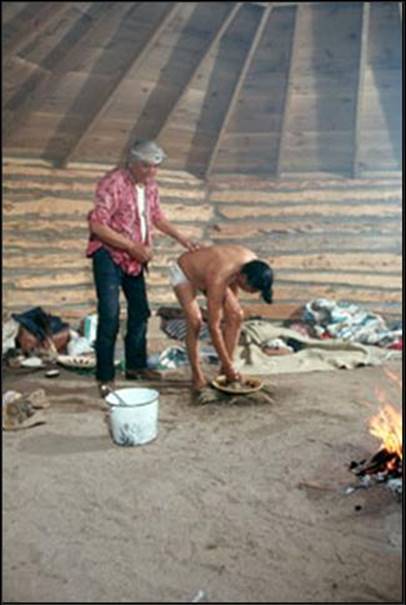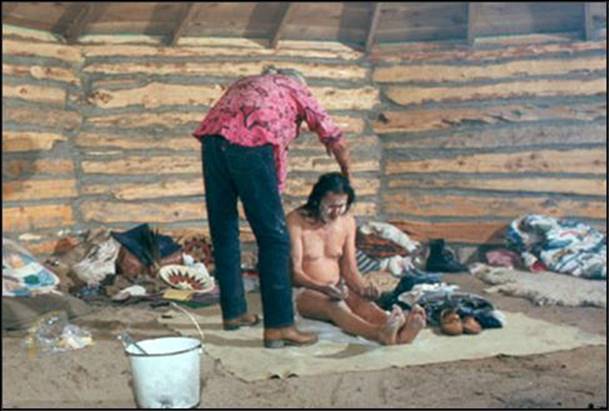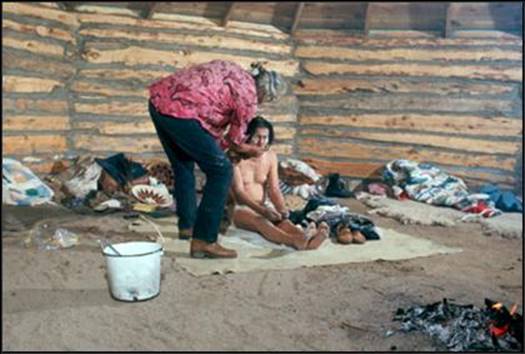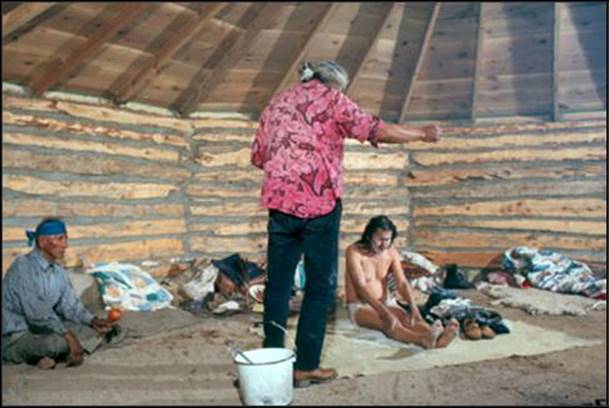COYOTEWAY – Pages 53-96
A Navajo Holyway Healing Ceremonial
Karl W. Luckert
and
Johnny C. Cooke,
Navajo Interpreter
5
Fire
Ceremonies
The procedures on the first four mornings of the
Coyoteway ceremonial are collectively called Fire Ceremonies (kQ
' baa
na'aldeehígíí) or
Rebuilding the Fire (ach'i'
déédíljah). Each of these four morning
ceremonies features a ritual in which Reed-prayerstick
Bundles (lók'aa
k'eet'áán násdizí) are presented to
various gods of the four directions. This procedure is followed each day by
a Sweating Rite. The four mornings of dual rites begin on the first morning
with Making New Fire. At the end of the fourth morning the Fire Ceremonies
are concluded with a Washing Ritual.
Making New Fire
The old fire in the hogan is extinguished
and the remains are carefully gathered and carried away. A dry piece of
wood, cut from the soft stem of a century plant, is placed as bottom piece
on a handful of shredded cedar bark. Notches are cut in the soft wood. Into
these notches are trickled some grains from a lightning-struck rock (tséghá-hindélii), not
only to transfer to the wood the fire-producing power of lightning, but also
"to increase friction." The drilling stick is made of some kind of hardwood;
the species of the wood may be varied. The stick is twirled between the
strong hands of two men, who take turns. But the wooden base refuses to glow
for quite some time. All the while the singer chants the words that relate
the present effort of making fire to the overall objective of healing:
Page 54
6. Song, First Morning, Fire-making Song
By sternness, whatever your name is, the Firestick
stands upright.(1)
By sternness, whatever your name is, the Firestick
stands upright.
By Earth and Sky, and
by sternness, whatever your name is, you are brought back.
By sternness, whatever your name is, the Firestick
stands upright.
By the Long-life Happiness One, and
by sternness, whatever your name is, you are brought back.
By sternness, whatever your name is, the Firestick
stands upright.
By sternness, whatever your name is, you are brought back.
(This song may be repeated as often as is necessary until the fire burns; it
ends as it begins with a repetition of the first line: "By sternness,
whatever your name is, the Firestick stands
upright.")
With all that effort in drilling and in singing, fire is still slow
at coming forth. Unfavorable foreign influences are suspected as being the
cause. A moratorium is put on my attempts in flash photography until there
is fire. The patient's battery-powered lantern is also switched off. Quite
obviously, the problem is a conflict between qualitatively different kinds
of fire. Indeed, these measures succeed. New fire appears -- sacred and pure
fire, which is suited for the purification of a patient, of a
hogan, and of all participants who take part in
the ceremonial.
The Reed-prayerstick Bundle Rites
PREPARATIONS
The
ritual of presenting Reed-prayerstick Bundles (lók'aa
k'eet'áán násdizí) as
offerings to various gods begins on the first morning immediately after the
fire making. From the second through the fourth mornings preparations for
the ritual are the first activity after awakening. Throughout the four
mornings the rite remains quite uniform; it always begins with the same
song, and it ends with a song that also remains the same. Four bundles are
made on each of the first three days; only two bundles are needed on the
fourth day. This variation is reflected in the prayers. They refer each day
to different divine recipients of the offering bundles; only two deities are
prayed to on the fourth day. Because the four Reed-prayerstick
Bundle Rites are
________________________________
(1) Sternness (hashké
yił deeyá) means
also "anger" and "severity."
Page 55
|
|
The stick is twirled between the strong hands of two men, who take
turns,
but the wooden base refuses to glow for quite some time.
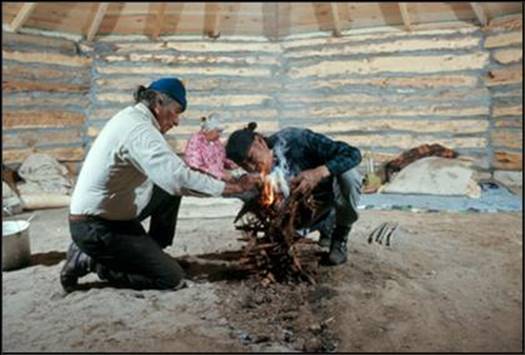 |
New Fire appears... sacred and pure fire.
Page 56
|
|
The ritual of presenting Reed-prayerstick
Bundles as offerings to various
gods begins on the first morning immediately after the Fire Making.
nearly identical, I can discuss them here as one unit. The differences that
by this method may appear, from one day to the next, do not interfere with
the presentation.
Allowing for some flexibility when it is dictated by the scarcity of
some materials, all offering bundles should, in addition to a Reed-prayerstick,
contain six items: a feather of a blue jay (ch'íshii
sháshii), of a bluebird (dólii), of
an eagle (átsá), of a turkey wing and
beard (tązhii, tązhii
bé'ézhóó'), together with a piece of cotton
string (ndik'ą'). While the bundles are
assembled, the divine recipients are addressed by a song:
7, 22, 37, 55. Song, First Through Fourth Mornings
I bring, these to you, I bring these to you,
I bring these to you, I bring these to you.
Beautiful Things I bring to you. Beautiful Songs I bring to you.
Under the Two Rising, I bring these to you.(2)
With the White One walking, I bring these to you,(2)
The White Prayerstick I bring to you.
______________________________________
(2) These lines were omitted on the first morning. The song, as a whole, is
very loosely structured.
Page 57
Beautiful White Beads I bring to you.
Beautiful Feathers I bring to you.
Beautiful Tobacco I bring to you ,(2)
Beautiful White Teeth I bring to you.
Beautiful White Salt I bring to you.
I bring these to you, I bring these to you.
Beautiful Cornpollen I bring to you.
Your own Son I bring to you,
the White Kinsman I bring to you,
the White Prayerstick I bring to you.
Multi-colored Shells I bring to you.
Beautiful Feathers I bring to you.
Beautiful White Teeth I bring to you.
These things are beautiful.
I bring these to you, I bring these to you,
I bring these to you, I bring these to you.
A Tobacco Stick of the Two Setting I bring to you,
the Yellow Prayerstick I bring to you.
The Yellow Cornpollen I bring to you.
Beautiful Feathers I bring to you.
Beautiful Teeth I bring to you.
Beautiful Things I bring to you,
Beautiful Things I bring to you.
Your own Son I bring to you,
the Yellow Kinsman I bring to you,
the Yellow Prayerstick I bring to you.
The Multi-colored Shell I bring to you.
Beautiful Feathers I bring to you.
Beautiful Teeth I bring to you.
Beautiful Things I bring to you. Beautiful Things I bring to you,
Beautiful Things I bring to you. Beautiful Things I bring to you.
A Tobacco Stick of the Two Above you I bring to you,
The Blue Prayerstick I bring to you.
Blue Turquoise Beads I bring to you.
Beautiful Feathers I bring to you.... (continued
as in second stanza)
The Songs of the North I bring to you.
The Black Prayerstick I bring to you.
Beautiful Cornpollen I bring to you.
Beautiful Feathers I bring to you.... (continued
as in second stanza)
/ bring these to you, I bring these to you,
I bring these to you, I bring these to you.
Page 58
|
|
…all offering bundles should, in addition to a Reed-prayerstick,
contain six items.
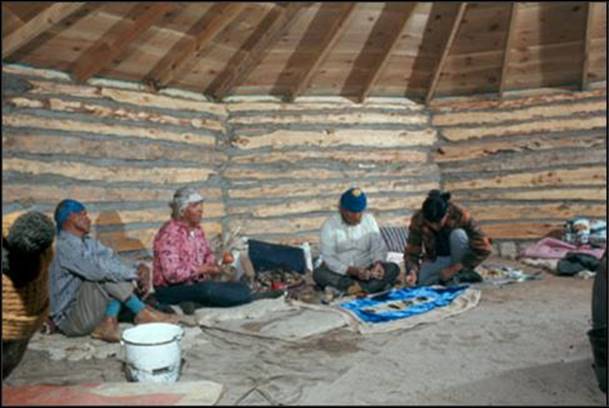 |
|
While the bundles are assembled, the divine recipients are
addressed by a song.
Page 59
The Reed-prayerstick is the most
important ingredient of the bundles. In fact, the offering bundles are named
after it. With a traditional flint arrowhead a four-inch section is cut
from the hollow stem of a common reed. The first ingredient of the stick is
pollen; then it is stuffed with Navajo tobacco (nát'oh
waa'í) -- with white-blossomed,
blue-blossomed, yellow-blossomed, and black-blossomed tobacco. Both ends of
the prayerstick are then plugged with a paste
made of water and pollen. Each stick is finally painted with the color that
belongs to the direction for which it is intended -- white for east, blue
for south, yellow for west, and black for north. The colors and paints are
obtained by grinding white bead (yoołgaii), turquoise (dootł'ishii), yellow
abalone shell (diichiłí), and jet (bááshzhinii).
The Reed-prayerstick is actually intended
to be a cigarette for the gods. Before it is put in the bundle it is
"lighted" and made ready for the Holy Ones to smoke. For that purpose a
quartz crystal is used to touch the tip of the
prayerstick; fire from the sun is mediated by way of the quartz
crystal.
From all this it would seem that the prayerstick
is a very straightforward gift to the gods -- a sort of friendly smoke
between them and men. But this is not entirely so. Along with the various
types of tobacco a small feather is smuggled inside. These cigarettes for
the gods are loaded. The feathers represent the missiles of witchcraft. And
so, while the Holy People enjoy and smoke their cigarettes, they unwittingly
burn the arrows that have affected the patient. After the helper has
finished his prayersticks he looks over his
work. This gives him the idea of lighting a cigarette for himself. His
smoke-stick is not loaded -- it happens to be a King-size Salem that I have
brought along.
Over all the contents in the offering bundles, before they are
folded, a powdered mixture composed of the following ingredients is
sprinkled: pollen from blue corn, from cattail reeds, from blue flowers, and
from pine trees, along with powdered seaweeds, ocean foam, jewel dust,
charcoal, and soil. After this, pollen is sprinkled toward the four
directions and in a circle. The singer explains with a subdued voice the
purpose of his action: "The offering bundles are blessed and become
efficacious only with pollen." The blessings of pollen are also sprinkled on
the patient; pollen is also put in the patient's mouth. Then the
practitioner proceeds to fold the bundles and gives them to the patient to
hold.
At this point in the preparations, on the first morning, some concern
can be noted on the face of the leader. He suspects that somehow in the
process the stack of offering bundles has been turned over and that the
sequence is now confused. The bundles must be arranged in the sequence in
which the prayers will be spoken; also, they must be
Page 60
arranged so that after the prayer they will be carried in the proper
direction. To make sure that all is well with the bundles, they are opened
once more to verify their destinations. The color of the prayer-sticks
identifies each bundle for the directional deity for whom it is intended.
The plant bundles that lie ready on the floor (first through third
mornings) are for the purification of the patient. In a similar manner as in
the wooltáád ceremony on the evening
before -- except for the pulling of strings -- the priestly practitioner
touches his patient with plant bundles of four or five ingredients, chosen
from among snake-weed (ch'il
diilyésii), blue grama
grass (tł'oh nástasí), Artemisia
frigida (tóyikááł), rock
sagebrush (ché'ézhííh), and spruce twigs (ch'ó). On
the fourth morning, however, the snow outside is so deep that the necessary
plants can not be found; therefore the singer
improvises and touches the patient with what he has available -- the
offering bundles. In any case, the patient is eventually given the Reed-prayerstick
bundles to hold.
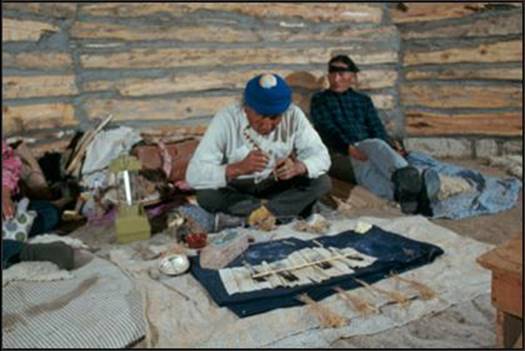 |
|
The first ingredient of the stick is pollen, then it is stuffed with
Navajo tobacco.
Page 61
|
|
After the helper has finished his prayersticks
he looks over his work.
This gives him the idea of lighting a cigarette for himself.
|
|
Over all the contents in the offering bundles, before they are
folded,
a powdered mixture... is sprinkled....
Page 62
|
|
After this, pollen is sprinkled toward the four directions
and in a circle.
Page
63
|
|
The blessings of pollen are also sprinkled on the patient.
|
|
...pollen is also put in the patient's mouth.
Page 64
|
|
Then the practitioner proceeds to fold the bundles.
|
|
To make sure that all is well with the bundles they are opened once
more.... The plant bundles that lie ready on the floor are for
the purification of the patient.
Page 65
|
|
On the fourth morning... the snow outside is so deep that the
necessary
plants can not be found… therefore the
singer improvises
and touches the patient with... the offering bundles.
PRAYERS
Holding
the offering bundles, the patient repeats the prayers as the words are first
spoken by the leader. In doing so he trails about a half sentence behind his
teacher. Each of the deities spoken to at the beginning of a prayer
receives a bundle. Only on the second day is each bundle intended to be
shared by two gods. The prayers for the first morning are as follows:
8. Prayer, First Morning
Early Morning, Shouting, Young Man! (White Coyote)
From you I have the essences of life.
Today we smoke tobacco together.
Today you will remake my feet.
Today you will remake my legs.
Today you will remake my whole body.
Today you will remake my whole mind.
Today you will remake the sound of my voice.
Today the magic that is doing this removes it from me.
You will remove them from me.
You have removed them from me.
You are taking them far away from me.
Page 66
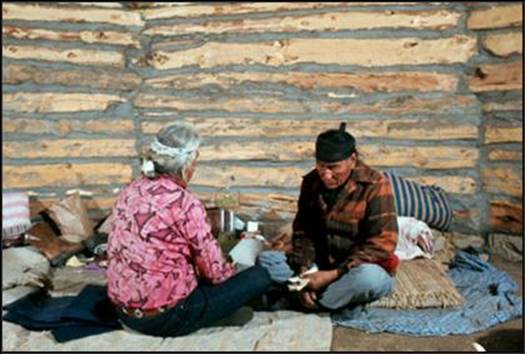 |
|
Holding the offering bundles, the patient repeats the prayers
as the words are first
spoken by the leader....
They are far away from me.
Today I will be made well again.
Today I am not hurting anymore.
Today you have removed them from me.
The illness is moving.
It has moved out.
It is moving away from me.
You made me as well as I have been before.
I have been made well, as well as I have been before.
I am healthy now.
I am walking, as before.
I am walking in health,
I am walking with a body free of fever.
I am walking with a light body.
I am walking with a perfect body.
I am walking with a body that is never to suffer again.
Happiness is before me.
Happiness is behind me.
The Long-life Happiness One, I am.
All is Happiness.
All is Happiness.
Page 67
This prayer is repeated on the first day for Yellow Evening Young
Woman (Shouting Yellow Coyote Woman), then for Sunbeam Young Man (Shouting
Blue Coyote), then for Darkness Shouting Young Woman (Black Coyote Woman).
The sequence, "Happiness before me" and "Happiness behind me," is reversed
with each successive prayer. Finally, the ending of the fourth prayer is
more elaborate than the previous endings:
Happiness is behind me.
Happiness is before me.
Happiness is under me.
Happiness is above me.
Happiness is all around me.
With Yellow Cornpollen, from my mouth, happiness
will come.
The Long-life Happiness One, I am.
All is Happiness.
All is Happiness.
After these prayers, spoken to specific gods, follows what might be
termed a "Prayer of Assurance." This prayer is identical on each of the four
mornings, regardless of what deities are addressed in the preceding
prayers.
According to these. Happiness will come to me from all places:
From the Flat Country, Happiness will come to me.
From the Plains, Happiness will come to me.
From the Thickets, Happiness will come to me.
From the Fogs, Happiness will come to me.
From the Hills, Happiness will come to me.
From the Gullies, Happiness will come to me.
From beneath Plants, Happiness will come to me.
From the Cornpollen path on which we walk,
Happiness will come to me.
From Holy Places in the Earth, Happiness will come to me.
From our Dwellings, Cornpollen Houses, Happiness
will come to me.
From out in the Woods, Happiness will come to me.
From beneath the Trees, Happiness will come to me.
From out of Canyons, Happiness will come to me.
From all red Canyons, Happiness will come to me.
From all black Canyons, Happiness will come to me.
From under the Rocks, Happiness will come to me.
From the Echoes of Canyon Walls, Happiness will come to me.
From stratified Rocks, Happiness will come to me.
Page 68
From Cliffs, Happiness will come to me.
From Shrubs, Happiness will come to me.
From Places eroded by Water, Happiness will come to me.
From Valleys with Spruce Trees, Happiness will come to me.
From the Holy Mountains, Happiness will come to me.
From the House of Darkness, Happiness will come to me.
From the House of Early Morning, Happiness will come to me.
From the High Places, Happiness will come to me.
From where Sunlight strikes first, Happiness will come to me.
From Mountain Peaks, Happiness will come to me.
From the Sky, Happiness will come to me.
From Places beyond the Sky, Happiness will come to me.
From Places where White Wind walks, Happiness will come to me.
From Places where Yellow Wind walks, Happiness will come to me.
From Places where Blue Wind walks, Happiness will come to me.
From Places where Black Wind walks, Happiness will come to me.
From Places where the Sons of Wind are walking, Happiness will come to me.
I will walk in places where good Dark Clouds keep coming.
I will walk in places where good Male Rain keeps falling.
I will walk in places where benevolent Lightning keeps flashing.
I will walk in places where good Black Fog is moving.
I will walk in places where good Female Rain keeps falling.
I will walk in places where good Rainbows float about.
I will walk in places where good Thunders are rolling.
I will walk in places where I hear the Water Bird.
I will walk in places where on cliffs the Birds are heard.
I will walk in places where the good Yellow Bird is heard.
I will walk in places where the Cornripener
Beetle is heard.
I will walk in places where chirps of good Young Birds are heard.
In places like these I will walk.
I will walk in places where every kind of Plant is growing.
I will walk in places where all sorts of Flowers are blooming.
I will walk among Dew and Pollen,
Pollen and Dew will touch my feet.
They will reach my legs.
By these the Breeze will blow through my hair.
By these the Breeze will penetrate my voice.
By these the Breeze will touch my sight.
By these the Breeze will enter my head.
By these the Breeze will affect my travels
Page 69
Happiness will come, behind me.
Happiness will come, before me.
Happiness will come, under me.
Happiness will come, above me.
Happiness will come, all around me.
With Cornpollen, Happiness will come from my
mouth.
The Long-life Happiness One I am, walking.
All is Happiness.
All is Happiness.
All is Happiness.
All is Happiness.
The four Prayerstick bundles on the
second morning are each made for two deities -- for a divine Wind and a
divine Coyote-person. The content of the bundles is identical with those of
the day before, except for additional diagonal stripes that are painted on
the prayersticks. These stripes are the symbol
of the Wind People. Accordingly, the formal prayers for presenting the
offering bundles are repeated on the second day for White Wind and White
Coyote in the east, for Yellow Wind and Yellow Coyote in the west, for Blue
Wind and Blue Coyote in the south, and for Black Wind and Black Coyote in
the north (niłch'i and mą'ii
łigaii, łitsooí,
dootł'izhí, łizhiní). (Prayer
23.)
On the third morning the four Prayerstick
bundles are given to Hidden Boy (a yaaghá
nilíní ashkii --
a Coyote), to White Dawn Girl (bidah
oogai at'ééd --
a Coyote Girl), to Flint Hill Boy (béésh dah
azk'idii ashkii --
a Coyote), and to Water Girl (bił
táálíní at'ééd --
a Coyote Girl). The formal prayers on that day, accordingly, are
addressed to these deities (Prayer 38).
On the fourth and final morning of the Fire Ceremonies only two
Prayerstick bundles are made. They contain white
and blue painted prayersticks. The white
Prayerstick bundle is for Talking-god (hashch'ééłti'i) in
the east; the blue one is for Calling-god (hashch'éoghan) in
the south. Accordingly, only two prayers, plus the "Prayer of Assurance,"
are required for the last of the Prayerstick
bundle rites (Prayer 56).
In this manner, by the time, fourteen
Prayerstick bundles have been delivered in the four directions, a
total of eighteen gods have been contacted: Talking-god the chief of the
Navajo pantheon and Calling-god, his closest helper; the four directional
Wind People; and altogether twelve different Coyote-persons -- the four
Shouting Coyotes, the four Coyotes who are simply identified by their
directional colors, together with Hidden Boy, White Dawn Girl, Flint Hill
Boy, and Water Girl.
Page 70
DELIVERY OF REED-PRAYERSTICK BUNDLES
On each of the first four mornings, after the formal prayers to the
gods who are to receive the prayerstick bundles,
the patient rises, circles the fire sunwise, and
carries the bundles to their destinations, about one half mile in the four
directions. As the patient rises, the singer folds the ground cloth that in
the process has become his. The patient walks east and south; because of the
severe snow a helper carries two bundles west and north for him. All bundles
are deposited under a tree or under some other living plant. The appropriate
opening phrases of the prayers that were spoken in the
hogan are repeated when the bundles are deposited -- to bring the
matter again to the god's attention. On the fourth morning the two bundles
that are made are taken east and south.
While the bundles are being carried outside, the singer in the
hogan chants a song. On some days a few helpers
remain to help him in the singing. The song that is being chanted recalls
the adventures of the first shaman, when he walked with the four directional
Coyote People, carrying prayersticks:
|
|
|
|
|
As the patient rises, the singer folds the ground cloth that in the
process has become his.
Page 71
|
|
While the bundles are being carried outside, the singer in
the hogan chants a song.
|
|
On some days a few helpers remain to help him in the singing.
Page 72
9, 24, 39, 57. Song, First Through Fourth Mornings
He has walked.
Beneath the Two Rising before you, he has walked.
With White Morning Boy, he has walked.
With Corn-pollen at his feet, he has walked.
With the White Prayerstick in his hand, he has
walked,
With Early Morning on him, he has walked.
With White Wind coming from his mouth, he has walked.
With Happiness before him, he has walked.
With Happiness behind him, he has walked.
He has walked; he has walked;
has walked, has walked, has walked, has walked.
Beneath the Two Setting before you, he has walked.
With Yellow Evening Girl, he has walked.
With Yellow Corn-pollen at his feet, he has walked.
With the Yellow Prayerstick in his hand, he has
walked.
With Yellow Evening on him, he has walked.
With Yellow Wind coming from his mouth, he has walked.
With Happiness behind him, he has walked.
With Happiness before him, he has walked.
He has walked; he has walked;
has walked, has walked, has walked, has walked.
Beneath the Two Above you, he has walked.
With the Sunbeam Boy, he has walked.
With Corn-pollen at his feet, he has walked.
With the Blue Prayerstick in his hand, he has
walked.
With Sunlight on him, he has walked.
With Blue Wind coming from his mouth, he has walked.
With Happiness before him, he has walked.
With Happiness behind him, he has walked.
He has walked; he has walked;
has walked, has walked, has walked, has walked.
Beneath Where-the-Stars-turn, he has walked.
With Darkness Girl, he has walked.
With Corn-pollen at his feet, he has walked.
With the Black Prayerstick in his hand, he has
walked.
With Darkness on him, he has walked.
With Black Wind coming from his mouth, he has walked.
With Happiness behind him, he has walked.
With Happiness before him, he has walked.
He has walked; he has walked;
has walked, has walked, has walked, has walked.
Page 73
After the song is finished, and when the bundle carriers have
returned, the hogan is made ready for the next
major portion of the Fire Ceremony. Firewood is carried inside for the
Sweating Rite.
The Sweating Rite
PREPARATIONS AND SWEATING
Together with the presentation of prayerstick
bundles to directional gods, the ritual of sweating constitutes another
major portion of the Fire Ceremonies. It is held on each of the first four
mornings, always after the prayerstick bundles
have been carried in the four directions.
Preparations for the Sweating Rite begin on the first evening with
chopping iiłkóóh medicine. A coarse
mixture of various plant materials, iiłkóóh consists
of three groups of ingredients: twigs of trees and bushes, water plants, and
portions of berry bushes. The twigs from trees and bushes are effective on
the patient's skin -- they are kQ'
dahólóní, "that which has fire." The six
species used are greasewood
|
|
Preparations for the Sweating Rite begin already on the first evening
with chopping iiłkóóh medicine.
Page 74
(díwózhii), juniper (gad), pinon (deestsiin), prickly
spruce and wide spruce (ch'ó
deinínii and teeł), and
pine (índíshchíí'). A group of six water
plants is aimed at affecting the patient's flesh. This group includes four
kinds of reeds (teeł,
teeł nííyizí, teeł
jik'ashí, teeł
Ukan), a plant the leaves of which look like
arrowheads -- possibly Brickellia grandiflora
petiolaris (tákáá'
béésh), and algae (tátł'id). Then
finally, seven plants of a reddish color are added to affect the patient's
blood. These are coyote berry -- Forestiera
neomexicana (mą'ii
bidąą'), choke-cherry (dzídzé), bitter
berry (dzídzé dik'QQzhii), service
berry (dzídzé dit'ódi), turquoise
berry (dzídzé dootł'izhí), wild
rose (chxQQh), and
something called tichíí'yistání. All
put together and eventually boiled, iiłkóóh becomes
a very strong tea; the flavors from the conifers dominate. Iiłkóóh medicine
is intended to be an emetic.
For the Sweating Rite on each of the four mornings the regular
fireplace, a converted oil drum with a stovepipe, is carried outside and a
fire is built at the center of the hogan. Laid
outward from the fire, in four directions, are four fire stirrers, each
nearly a yard long. A juniper stick(gad) lies pointing east, a pinon
stick (deestsiin) west, an oak stick (chech'il) south,
and a scrub-oak stick (chech'il
ntł'izi) pointing north.
Before the patient, that is, in a northwesterly direction from the
fire, two features are being readied. A pile of sand is shaped in the form
of a crater, as if to receive something. Iiłkóóh medicine
is an emetic, and the patient later on explained the feature in terms of
Coyote's vomiting. However, as far as I can presently see through the
generally heavy smoke, our patient never vomits; neither do I nor does
anybody else who drinks from the iiłkóóh brew.
The crater of sand at any rate receives the solid remains of the rubbed-on iiłkóóh medicine.
South of the sandpile a basket is placed in
which medicines -- first iiłkóóh for
drinking and for rubbing-on, and later kétłoh for
sprinkling -- are prepared. Iiłkóóh medicine
is first boiled in a large pot by the open fire. Kétłoh medicine,
a dry mixture of plant materials, is simply sprinkled on iiłkóóh liquid
in the basket. Kétłoh medicine
used in the Sweating Rite is the same as that which has already been
described for the Unraveling Ceremonies.
When all these things are in their proper places, all the
participants disrobe, down to their shorts or breech cloths. Only men are
present for this rite. The practitioner's modesty, faced with photographic
equipment, is the reason why no pictures are taken during the sweating
sessions. Tape-recording, sketching, and note-taking are, fortunately, all
right. The shadow-drawing given here is based on notebook sketches, memory,
and on previous photographic data.
Page 75
|
|
When all these things are in their proper places, all the
participants
disrobe down to their shorts or breech cloths...
the leader sings a song about "the fur of the patient."
Then, as the flames shoot up toward the smoke-hole, and as the smoke
builds up to a nearly unbearable density (the new hogan
is not yet adequately ventilated), the leader sings a song about "the fur of
the patient" -- which by way of ceremonial participation in the archetypal
mythical event is identical with the fur of Coyote. The white, yellow, blue,
and black water (iiłkóóh medicine) is
presently boiling by the fire to be eventually put on the "fur" of the
patient -- after that on the "furs" of all the participants, including mine.
The structure of the song is simple -- perhaps one of the oldest in the
Coyoteway ceremonial:
10. Song, First Morning
This is the Fur, this is the Fur.
On the Tips of the Fur is the White Water.
On the Tips of the Fur is the White Medicine.
This is the Fur, this is the Fur.
On the Tips of the Fur is the Yellow Water.
On the Tips of the Fur is the Yellow Medicine.
This is the Fur, this is the Fur.
On the Tips of the Fur is the Blue Water.
On the Tips of the Fur is the Blue Medicine.
This is the Fur, this is the Fur.
Page 76
On the Tips of the Fur is the Black Water.
On the Tips of the Fur is the Black Medicine.
This is the Fur, this is the Fur.
These are put on the Fur, these are put on the Fur.
The White Fur,
The White Water,
The White Medicine,
This is the Fur, this is the Fur.
These are put on the Fur, these are put on the Fur.
The Yellow Fur,
The Yellow Water,
The Yellow Medicine,
This is the Fur, this is the Fur.
These are put on the Fur, these are put on the Fur.
The Blue Fur,
The Blue Water,
The Blue Medicine,
This is the Fur, this is the Fur.
These are put on the Fur, these are put on the Fur.
The Black Fur,
The Black Water,
The Black Medicine,
This is the Fur, this is the Fur.
The Beautiful Fur, the Beautiful Fur.
The White Fur,
The White Water,
The White Medicine…
(Continued as in last stanza for Yellow Fur, Yellow Water, Yellow Medicine
-- then Blue, and Black)
The preparational song with which sweating is begun on the second
morning (Song 25) is a variation of the first morning's opening song (Song
10). The Coyote-identification, where the patient's skin has become Coyote's
fur, is now developed into a more complete Coyote mysticism. The ceremonial
hogan, made of clay and logs, becomes a cosmic
dwelling by virtue of its association with a complete set of directional
colors. Moreover, the ceremonial hogan is now
"in" the white, yellow, blue, and black Fur; that is to say, all
participants are presently inside a Coyote-being of cosmic dimensions. The
entire process of healing and initiation, even my recording, is accomplished
in mystical union, literally "inside," the great Coyote.
Page 77
25. Song, Second Morning
This is the Hogan, this is the Hogan,
This is the Hogan, this is the Hogan.
This is the Hogan given to me.
This is the White Clay Hogan.
This is the Hogan in the White Fur.
This is the Hogan that is immune.
This is the Hogan given to me.
This is the Hogan, this is the Hogan,
This is the Hogan, this is the Hogan.
This is the Hogan behind the Hill.
This is the Hogan in the Yellow Fur.
This is the Hogan of the Abalone Shell Lady.
This is the
Hogan that is immune.
This is the
Hogan built of Logs.
This is the Hogan, this is the Hogan,
This is the Hogan, this is the Hogan.
This is the Hogan built of Logs.
This is the Hogan in the Mountains.
This is the Hogan in the Blue Fur.
This is the Hogan that is immune.
This is the Hogan built of Logs.
This is the Hogan, this is the Hogan,
This is the Hogan, this is the Hogan.
This is the Hogan on top of the Mountain.
This is the Hogan in the Black Fur.
This is the Brown Hogan on top of the Mountain.
This is the Hogan that is immune.
This is the Hogan built of Logs.
This is the Hogan, this is the Hogan,
This is the Hogan, this is the Hogan.
This is the Hogan of your Son.
This is the Hogan that is immune.
This is the Hogan built of Logs.
This is the Hogan on top of the Mountain.
This is the Hogan of your Son,
This is the Hogan, this is the Hogan,
This is the Hogan, this is the Hogan.
Referring specifically to the seven reddish plant ingredients in the iiłkóóh brew,
which are presently boiling by the fire, the priestly singer continues on
the first morning with this song:
Page 78
11, Song, First Morning
The Red Berry Shrubs are Medicine for my blood.
They are Medicine, they are Medicine,
They are Medicine, they are Medicine.
The Sons of these Medicines will help my blood.
They will help, they will help,
They will help, they will help.
The Sons of these Medicines are affecting, my blood.
They are affecting, my blood, they are affecting, my blood,
They are affecting, my blood, they are affecting my blood.
(This song is chanted four times.)
The next song depicts the setting of the timeless ceremonial; it
refers to the first patient's recovery:
26. Song, Second Morning
On these he walked, on these he walked,
On these he walked, on these he walked.
The Walking, that is immune he walked.
On the White Grass he walked,
the Walking that is immune he walked.
On the Blue Grass he walked,
the Walking, that is immune he walked.
On the Black Grass he walked,
the Walking, that is immune he walked.
On the Yellow Grass he walked,
the Walking that is immune he walked.
On these he walked.
On the Ground he walked, on the Ground he walked,
On the Ground he walked, on the Ground he walked.
On the White Ground he walked.
On the White Grass he walked.
The Walking that is immune he walked.
On the Ground he walked, on the Ground he walked.
(The second stanza is repeated for Yellow Ground, Grass, Walking, then for
Blue and Black. Song ends with four-fold refrain.)
The song which follows refers to the medicine which presently is
being made -- the iiłkóóh brew which
boils by the fire:
Page 79
27. Song, Second Morning
The Medicine is being made, the Medicine is being made,
The Medicine is being made, the Medicine is being made.
The Adulterous Coyote (ma'ii
ah'ihtii) is making the medicine.
The Medicine is being made.
The Medicine he carries on his back.
The Medicine is being made.
The White Medicine,
The Medicine is being made.
The Holy Medicine,
The Medicine is being made.
Beneath the Two Rising,
The Medicine is being made.
The Medicine is being made, the Medicine is being made,
The Medicine is being made, the Medicine is being made.
The Staggering Coyote (atiin
dooldisi) is making the medicine.
The Medicine is being made.
(Coming) from the Steep Places,
The Medicine is being made.
The Yellow Medicine,
The Medicine is being made.
The Holy Medicine,
The Medicine is being made.
Where the Two Above are setting,
The Medicine is being made.
The Medicine is being made, the Medicine is being made,
The Medicine is being made, the Medicine is being made.
The Badger (nahashch'id) is
making the medicine.
The Medicine is being made.
(Coming) from the Dark Soil,
The Medicine is being made.
The Blue Medicine,
The Medicine is being made.
The Holy Medicine,
The Medicine is being made.
Beneath the Two Above,
The Medicine is being made.
The Medicine is being made, the Medicine is being made,
The Medicine is being made, the Medicine is being made.
The Gopher (na'azisi) is
making the Medicine.
The Medicine is being made.
Page 80
(Coming) from the Dark-brown Places,
The Medicine is being made.
The Jet-black Medicine,
The Medicine is being made.
The Holy Medicine,
The Medicine is being made.
Where the Big Dipper turns,
The Medicine is being made.
The Medicine is being made, the Medicine is being made,
The Medicine is being made, the Medicine is being made.
The preparational and sweating songs on the third and fourth mornings
are identical. As before, the songs refer to the healing of the first
Coyoteway patient. The references in the next
two songs, to feathers and to feathers hanging down, will be better
explained later on in Songs 42 through 45. Presently we join the patient as
he is "walking out again," and as "he is walking in the water" -- he and all
those with him are sweating:
40. 58. Song, Third and Fourth Mornings
With these, with these, he walked out again.
With these, with these, he walked out again.
With a Stick, he walked out again.
With the Sun above him, he walked out again.
With the Waterbird People above him, he walked
out again.
With this Medicine, he walked out again.
With this Feather, he walked out again.
With the White Feather hanging down, he walked out again.
With his Body, he walked out again.
With these, with these he walked out again.
With these Feathers, he walked out again.
With the Sun above him, he walked out again.
With the Waterbird People above him, he walked
out again.
With this Medicine, he walked out again.
With this Feather, he walked out again.
With these Feathers hanging down, he walked out again.
With his Body well, he walked out again.
With these, with these, he walked out again. He is well.
41. 59. Song, Third and Fourth Mornings
He is walking in the water, he is walking in the water,
He is walking in the water, he is walking in the water.
Page 81
With the Sun as his shield, he is walking in the water.
With these, he is walking in the water.
With the Heat People, he is walking in the water.
With the Sun as his shield, he is walking in the water.
With the Heat People, he is walking in the water.
With Feathers on his Head, he is walking in the water.
With Feathers hanging down, he is walking in the water.
With his Body shaking, he is walking in the water.
He is walking in the water, he is walking in the water,
He is walking in the water, he is walking in the water.
With being hot, he is walking in the water.
With the Sun as his shield, he is walking in the water.
With Feathers hanging down, he is walking in the water.
With Feathers hanging down, he is walking in the water.
With the White Feather, he is walking in the water.
With these, with these, he is walking in the water.
He is walking in the water, he is walking in the water,
He is walking in the water, he is walking in the water.
IIŁKÓÓH RUBBING-ON
AND DRINKING
After the preparational sweating songs, the practitioner pours the
boiling iiłkóóh brew from the pot
into the basket near the patient. The patient then sifts the solids from the
liquid by using a coarse brush; he rubs them on his body in such a manner
that the rubbings fall into the sand hollow near the basket. Then he kneels
and bows low to drink some of the liquid, directly from the basket. What he
does not drink he rubs on his body. The other participants receive some of
the liquid served in bowls -- the singer drinks his portion directly from
the dipper. While this takes place, on the first day, he chants three songs:
12. Song, First Morning
It is his Water, it is his Water,
It is his Water, it is his Water.
It is the White Medicine's Water.
It is the White Fur's Water.
It is the White Medicine's Water.
It is the Holy Medicine's Water.
It is his Water, it is his Water,
It is his Water, it is his Water.
(This stanza is repeated for Yellow, Blue, and Black. See Song 46 for a
later variation.)
Page 82
23. Song, First Morning
He who was given, lifts me by his hand.
He who was given, lifts me by his hand.
The White Fire-drill Bottom Piece, lifts me by his hand.
The White Medicine, lifts me by his hand.
The Holy Medicine, lifts me by his hand.
These who were given, lift me by their hands.
These who were given, lift me by their hands.
These who were given, lift me by their hands.
These who were given, lift me by their hands.
(This stanza is repeated for Yellow, Blue, and Black.)
14. Song, First Morning, same as Song 11
The Red Berry Shrubs are Medicine for my Blood....
The songs that are chanted for iiłkóóh drinking
and rubbing-on during the second Sweating Rite refer to the medicine which
is now ready. The medicine will have been already sipped by the time the
subsequent Song 29 is being chanted.
28. Song, Second Morning
The Medicine is ready, the Medicine is ready,
The Medicine is ready, the Medicine is ready.
The Adulterous Coyote has made the Medicine ready.
The Medicine is ready.
Behind the Mountains where the trail goes,
The Medicine is ready.
The White Medicine,
The Medicine is ready.
The Holy Medicine,
The Medicine is ready.
The Son of the Two Rising, it is he who has made the Medicine ready.
The Medicine is ready, the Medicine is ready,
The Medicine is ready, the Medicine is ready.
The Staggering Coyote has made the Medicine ready.
The Medicine is ready.
(Coming) from the steep Slopes,
The Medicine is ready.
The Yellow Medicine,
The Medicine is ready.
The Holy Medicine,
The Medicine is ready.
Page 83
The Son of the Two Setting, it is he who made the Medicine ready.
The Medicine is ready, the Medicine is ready,
The Medicine is ready, the Medicine is ready.
(The next stanza is for Badger, the last stanza for Gopher -- all after the
pattern of Song 27.)
29. Song, Second Morning
The Medicine I ate, the Medicine I ate,
The Medicine I ate, the Medicine I ate.
The Adulterous Coyote has made the Medicine, the Medicine I ate.
Behind the Mountains where the trail goes, the Medicine I ate,
The White Medicine....
(All four stanzas are patterned after Song 28. Only the refrain is new.)
Then on the third and on the fourth mornings of the Sweating Bite,
while iiłkóóh is being sipped, four songs
celebrate the effects of this praiseworthy medicine. The feathery arrows of
witchcraft are "coming out" from the patient's body; along with drops of
sweat they are "dripping"; they are "falling"; and as a result of all these
happenings -- and as a result of the progression of these songs -- the
patient is made "well":
42, 60. Song, Third and Fourth Mornings
With these, with these, it is coming out.
With these, with these, it is coming out.
From the bones, it is coming out.
With the Sun as his shield, it is coming out.
With the Waterbird People above him, it is
coming out.
With the Feathers hanging down, it is coming out.
With his body shaking, it is coming out.
With his body shaking, it is dripping.
With his body shaking, it is falling.
With his body shaking, he is well.
With these, with these, it is coming out.
With these, with these, it is coming out.
With the Heat, it is coming out.
With the Sun as his shield, it is coming out.
With the Waterbird People above him, it is
coming out.
With the Feathers on his head, it is coming out.
With the White Feathers hanging down, it is coming out.
With his body shaking, it is coming out.
With his body shaking, it is dripping.
Page 84
With his body shaking, it is falling.
With his body shaking, he is well.
With these, with these, it is coming out.
With these, with these, it is coming out.
43. 61. Song, Third and Fourth Mornings
With these, with these, it is dripping.
With these, with these, it is dripping.
With the Feathers falling, it is dripping.
With the Sun as his shield, it is dripping....
(Continued after the pattern of Song 42)
44. 62. Song, Third and Fourth Mornings
With these, with these, it is falling.
With these, with these, it is falling.
With the body shaking, it is falling.
With the Sun as his shield, it is falling....
(Continued after the pattern of Song 42)
45. 63. Song, Third and Fourth Mornings
With these, with these, he is well.
With these, with these, he is well.
With the Feathers falling, he is well.
With the Sun as his shield, he is well....
(Continued after the pattern of Song 42)
That some songs can be used to serve different purposes becomes
evident if one examines the sequential scheme at the end of the third and
the fourth day of sweating. Song 46, of the third day, is identical with
Song 64 of the fourth day; however, while on the third morning it is chanted
to complete the iiłkóóh rubbing, on the
fourth morning it substitutes for the regular sprinkling song:
46. 64. Song, Third and Fourth Mornings
It is his water, it is his water.
A White Coyote's water, it is his water.
The White Water he is walking in, it is his water.
The White Medicine, it is his water.
The Holy White Medicine, it is his water.
It is his water, it is his water.
(This stanza is repeated for Yellow, Blue, and Black.)
Page 85
The
following song, like the previous one, is a variation of Song 12 and 13 with
which actions were begun in the Sweating Rite on the first morning:
47. Song, Third Morning
He who was given lifts me in his hand.
He who was given lifts me in his hand.
The White Reed, lifts me in his hand.
The White Medicine, lifts me in his hand.
The Holy Medicine, lifts me in his hand.
He who was given lifts me in his hand.
He who was given lifts me in his hand.
(This stanza is repeated for Yellow, Blue, and Black.)
After the iiłkóóh medicine is
properly applied, the patient rises, circles the fire
sunwise, and goes outside. While he is absent, the helpers gather
every trace of his iiłkóóh rubbings and
the entire pile of sand. Together with the illness that has been captured
there, these things are carried outside and disposed of at some distance. At
this time also half of the fire is taken outside and deposited north of the
hogan -- further
north on each successive morning. While these disease-absorbing elements are
carried away, the patient waits outside; he keeps his distance to avoid
catching the illness again. When he finally returns, the priestly singer
prepares for sprinkling the participants with kétłoh medicine.
SPRINKLING KÉTŁOH
Every
Sweating Rite includes sprinkling of kétłoh medicine
-- the same rub-on medicine which has been described in connection with the
Unraveling Ceremonies. The practitioner pours the remaining iiłkóóh liquid
from the pot by the fire into his basket. To the liquid he adds kétłohpowder.
With a bundle of large eagle feathers, and with a song, the priest begins
sprinkling the wholesome contents of the basket first on the patient, then
on every participant around the circle, sunwise.
I happen to sit on the south side and am therefore the first of the
participants to get showered. On the first day I dodge the liquid to protect
my recording equipment -- the singer laughs out loud, nearly interrupting
his song. His sport from here on out is to aim his load straight at my face.
On the second day I know what to expect; I quietly cover my equipment and
solemnly present my face to his showers of blessings. He is surprised, even
takes a second look to reassure himself. I have the feeling that he respects
me for it. The next round is sprinkled
Page
86
more generally for the cardinal directions. Last to be blessed is the
practitioner's own pad and his equipment.
The words of the sprinkling song are quite significant in this
procedure. On the fourth morning the singer sprinkles to Song 64, "It is
his water" (same as Song 46 above). The liquid medicines that are used in
any rite of the Coyoteway ceremonial are
Coyote's water. The idea of getting blessed by Coyote's water is carried one
step further in the sprinkling song that is used on the first three
mornings. According to this song, the furs which "are put in the water" --
are being sprinkled -- are the
coyote furs of the patient and of all the participants. All of us
participate, ceremonially, in a fully developed Coyote mysticism. And here
is the song:
15, 30, 48, Song, First Through Third Mornings
The Furs are put in the water.
Black Lightning, is put in the body.
Male Rain is there.
Black Water is there.
Crystal Rock is there.
In the wide Land I walk.
The Black Fur is put in the rainbow.
It is put in the Black Water.
The White Crystal is there.
Roads to the wide Land I walk.
The Holy Black Cloud is there.
Crystal Rock is there,
In the Black Water I walk.
To the Beautiful Place I walk.
In the Country of Water I walk.
Furs put into Corn-pollen,
And beautiful Water is there.
BURNING THE FEATHERS
Every
major ceremony in the Coyoteway ceremonial,
except the ninth night, concludes with the act of burning the feathers. The
procedure and the meaning are always the same. Arrows of witchcraft -- bird
feathers shot into the primeval Coyote skin -- are burned, removed, and
blown far away from the patient. The fiery coal, again, is drenched with
water and carried outside with some of the illness adhering to it. The
Feather-burning Rite is generally a silent procedure. Only at the end of
the fourth Sweating Rite it is accompanied by a song. Structurally this song
is a continuation of Songs 42 through 45.
Page
87
(same as 60 through 63). The song recognizes the accomplished fact of the
exorcistic process which in Song 5, the song following feather-burning in
the Unraveling Ceremony, is still going on. Now the witchcraft feathers are
not only heard whizzing away; now it is certain that "they have blown far
away."
65. Song, Fourth Morning
They have blown far away, they have blown far away,
They have blown far away, they have blown far away.
With the Sun as your shield, they have blown far away.
With the Hardwood Shrub People (burning), they have blown far away.
With the Bird People above, they have blown far away.
With the Ones that stand above, they have blown far away.
With these you are made well, with these you are made well,
With these you are made well, with these you are made well,
With the Bear People, they have blown far away.
With the Sun as your shield, they have blown far away.
With all Furry People, they have blown far away.
With the body shaking, it is coming out.
With the body shaking, it is dripping.
With the body shaking,, it is falling,
With the body shaking, you are made well.
They have blown far away, they have blown far away,
They have blown far away, they have blown far away.
The Washing Rite
The four Fire Ceremonies are concluded on the fourth morning with the
Washing Rite. An open fire burns at the center of the
hogan. A bucket load of sand is brought in and put between the fire
and the patient. The sand is leveled. Spruce twigs are laid on the sand;
snake-weed and other grasses -- the same as are in the wooltáád bundles
-- are laid on the spruce twigs. Finally, a basket is set on top of these.
Hot water is poured into the basket, and while the patient undresses, the
singer works up a lather by wringing yucca leaves. The patient circles the
fire, sunwise. On the white yucca suds, in the
basket, the practitioner sprinkles greenish kétłoh powder
in the shape of the familiar circle, with the four directional lines leading
out from the center.
Then the patient kneels to face the basket; the singer loosens the
man's hair. The hair is washed in the yucca suds. After the hair the entire
body is cleansed. The remains of this procedure -- spilled suds,
Page 88
sand, and the disease-absorbing plants -- are all carried outside. The act
of washing, up to this point, has obviously been an exorcistic rite of
purification. The song that is chanted to accompany the washing, however,
dwells on the positive aspect: since mythical times, by the efforts of
Coyoteway singers, health, long life, and
happiness were "brought back."
66. Song, Fourth Morning
He brought it back, he brought it back,
He brought it back, he brought it back.
With these he brought it back.
The Sons of Sun, with these he brought it back....
(This song is the same as Song 31.)
Water cleanses from dirt and even washes away the exorcized missiles
of witchcraft. It cleanses and removes, but it does not replenish the vacuum
that in this process of healing is created. Therefore, immediately after the
washing, the patient's hair, face, and body are infused with new life-power
through the application of cornmeal.
|
|
|
|
|
An open fire burns at the center.... A bucket load of sand.
between the fire and the patient... is leveled.
Page 89
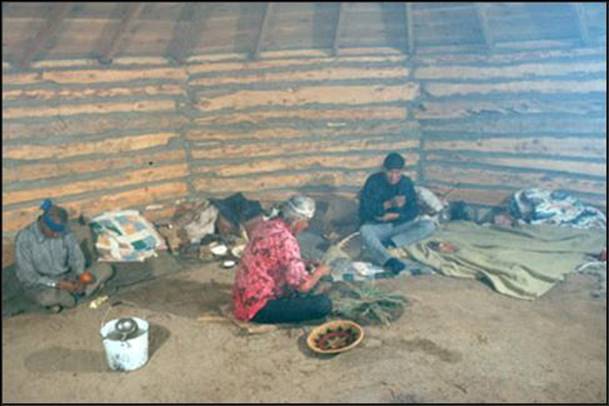 |
|
Spruce twigs are laid on the sand; snakeweed and other grasses...
are laid on the spruce twigs.
|
|
Hot water is poured into the basket... the singer works up a
lather by wringing yucca leaves.
Page 90
|
|
On the white yucca suds... the practitioner sprinkles
greenish kétłoh powder in
the shape of the familiar circle,
with the four directional lines leading out from the center.
|
|
Then the patient kneels to face the basket; the singer
loosens the man's hair.
Page 91
|
|
His hair is washed in yucca suds.
After a while the patient continues applying the cornmeal by himself. He
also puts cornmeal on his clothes. This, surely, is no longer purification,
but rather an addition of positive powers. Meanwhile, the singer chants a
song -- variations on Song 2. The modifications are noteworthy. The
exorcistic implications of the original Song 2 -- "Now it has begun moving"
-- are replaced here by a direct reference to the patient's ability to move
and to walk about in health:
67. Song, Fourth Morning
Now he is moving, now he is moving,
Now he is moving, now he is moving.
With the help of these he is moving:
With the Sons of Sun, he is moving.
With the Sons of White Corn Girl, he is moving.
With Dark Cattails on top, he is moving.
With the Flash of Lightning, he is moving.
With the Black-blossomed Plant, he is moving.
With the Sound of Lightning, he is moving.
With the Long-life Happiness One, he is moving.
Now he is moving, now he is moving,
Now he is moving, now he is moving.
Page 92
|
|
|
|
|
After the hair the entire body is cleansed.
Page 93
|
|
...the patient's hair, face, and body are therefore infused with new
life-power through the application of cornmeal.
With the Sons of Moon, he is moving.
With the Sons of Yellow Corn, he is moving.
With Dark Cattails on top, he is moving.
With the White Rainbow, he is moving.
With the Yellow-blossomed Plant, he is moving.
With the Corn-ripener Beetle, he is moving.
With the Long-life Happiness One, he is moving.
Now he is moving, now he is moving,
Now he is moving, now he is moving.
68. Song, Fourth Morning
Now he is walking, now he is walking,
Now he is walking, now he is walking.
With the help of these he is walking:
With the Sons of Sun, he is walking....
(Sung after the pattern of Song 67.)
After these songs the practitioner blesses the patient with pollen;
he puts some pollen into the patient's mouth, then some on his head. Then he
sprinkles pollen in the four directions and explains: "The suds of
Page 94
yucca alone do not heal a person. When the blessings of corn pollen are
added, real renewal takes place." Now a pollen bag is passed so that all of
us can obtain the same blessings. In the end the singer sprinkles pollen on
his paraphernalia and gets ready to sing again.
After pollen-sprinkling the thematic progression of Songs 66 through
68 -- "He brought it back," "Now he is moving," "Now he is walking" -- is
continued in two more songs. In these final songs the patient is no longer
referred to in third person singular; rather, he now exclaims in first
person singular "It is I walking!" and "It is I made strong!" He no longer
sees himself as a shadow-figure in the trail of that first
Coyoteway patient and shaman; he now is that
first patient and shaman.
69. Song, Fourth Morning
It is I, it is I walking!
It is I, it is I walking!
It is I, it is I walking!
It is I, it is I walking!
The White Corn Boy, it is I walking.
Beneath the Two Rising, on White Mountain, it is I walking.
|
|
|
|
|
...the practitioner blesses the patient with pollen; he puts some
pollen into the patient's mouth.
Page 95
|
|
Then he sprinkles pollen in the four directions and explains...
With Pollen, it is I walking.
Happiness before me, it is I walking.
Happiness behind me, it is I walking.
It is I, it is I walking!
It is I, it is I walking!
It is I, it is I walking!
It is I, it is I walking!
The Yellow Corn Boy, it is I walking.
Beneath the Two Setting, on Yellow Mountain, it is I walking....
(continued as in first stanza)
The Blue Corn, it is I walking.
Beneath the Two, on Blue Mountain, it is I walking....
(continued as in first stanza)
The Black Corn, it is I walking.
Beneath where Big Dipper turns, it is I walking....
(continued as in first stanza)
70. Song, Fourth Morning
It is I, it is I made strong!
It is I, it is I made strong!
Page 96
It
is I, it is I made strong!
It is I, it is I made strong!
The White Corn Boy, it is I made strong....
(continued after the pattern of Song 69)
These songs conclude the Washing Rite, the Fire Ceremonies, and so
the first four days of the Coyoteway ceremonial.
This is the end of the fourth morning. Tonight, on the fifth evening of the
ceremonial, the Basket-drum Singing will begin.
